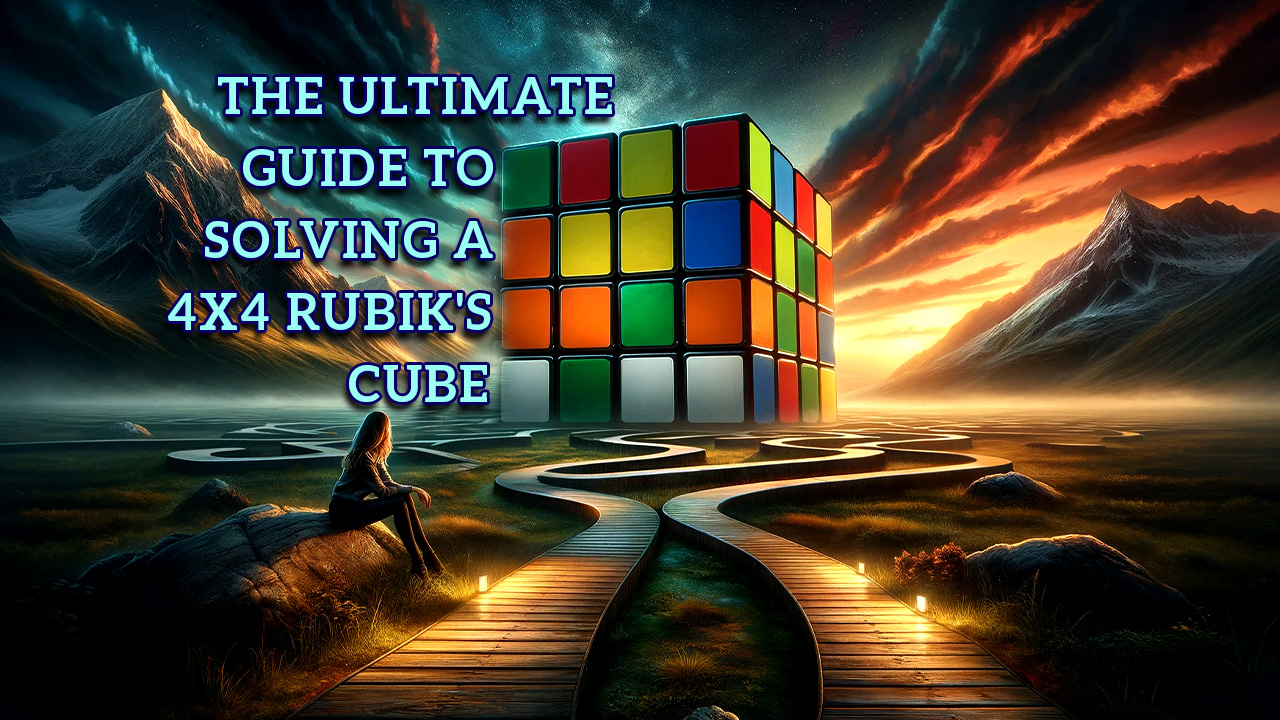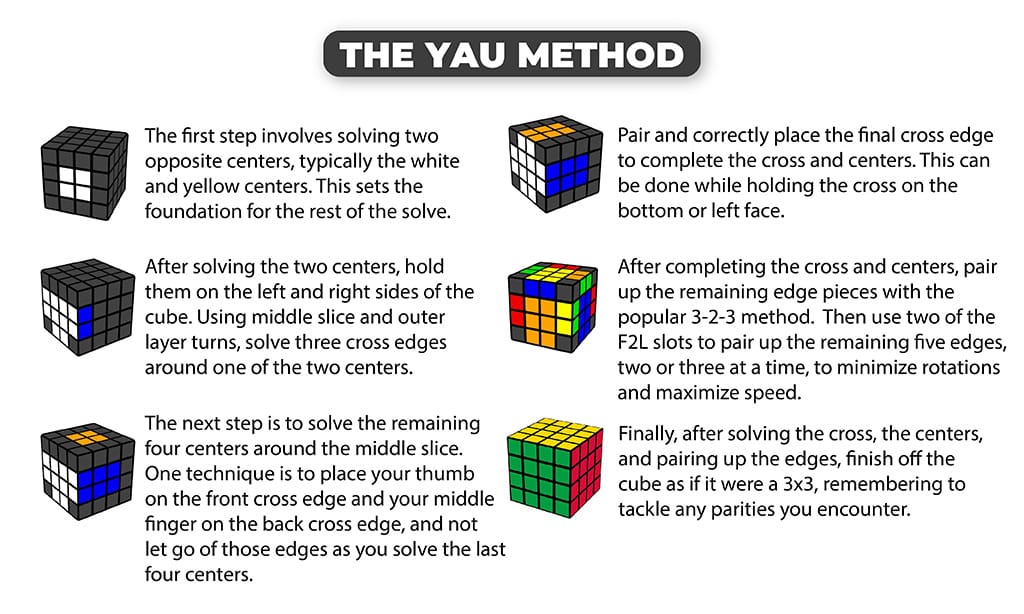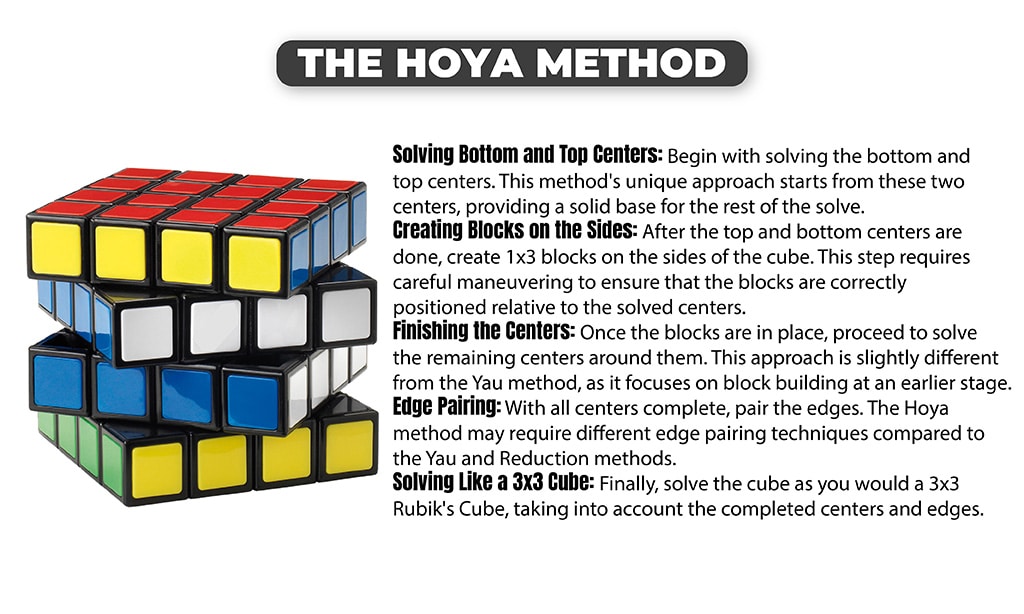The 4×4 Rubik’s Cube, also known as the Rubik’s Revenge, presents a thrilling yet challenging puzzle for enthusiasts and solvers worldwide. Unlike its predecessor, the 3×3 cube, the 4×4 introduces a more complex structure, lacking a fixed center piece and offering a greater variety of configurations.
This complexity elevates the solving experience, requiring not only an understanding of the cube’s mechanics but also the application of specialized strategies and techniques.
In this guide, we’ll discuss the topic of Rubiks cube solver 4×4. Apart from that, we’ll address common pitfalls and provide tips to enhance both speed and accuracy.
This guide is crafted to transform novices into proficient solvers and elevate the skills of intermediate enthusiasts. By its conclusion, you’ll not only be adept at solving the 4×4 cube but also be on the path to solving it like a pro, with insights and wisdom gleaned from expert solvers.
4×4 Rubik’s Cube: Understanding its Unique Mechanics and Challenges
The 4×4 Rubik’s Cube, often referred to as the Rubik’s Revenge, stands as a formidable upgrade to its classic 3×3 counterpart. Introduced in the early 1980s, this puzzle cube adds layers of complexity that entice and challenge puzzle enthusiasts around the globe.
Understanding the Structure
Unlike the 3×3 cube, the 4×4 cube lacks fixed center pieces, which are crucial for determining the color of each face in the traditional cube.
This absence transforms the solving process, as it requires the solver to determine the color scheme dynamically as they solve. Additionally, the cube comprises 56 smaller pieces, significantly more than the 26 pieces of a standard 3×3 cube.
Increased Configurations
The 4×4 cube offers a staggering number of possible configurations, exponentially more than the 3×3. This vast array of possibilities makes the 4×4 cube a puzzle of prediction, memory, and strategy, pushing the boundaries of what is achievable in a hand-held puzzle.
Parity Errors
A unique aspect of the 4×4 cube is the occurrence of parity errors. These errors arise because the cube allows configurations that seem solvable but actually are not due to the hidden orientation of the center pieces. Solving these parity errors requires specific algorithms, adding an extra layer of complexity to the puzzle.
Mechanical Differences
The internal mechanism of the 4×4 cube also differs from the 3×3. The lack of a fixed center results in a unique turning experience.
The cube can feel both loose and challenging to align, especially during complex moves. It’s essential for solvers to familiarize themselves with the feel of their cube, understanding how it moves under various pressures and angles.
Solving Approach
The approach to solving a 4×4 cube is fundamentally different from the 3×3. Solvers must first solve the centers, pair the edges, and then proceed to solve it like a 3×3 cube. This layered approach to solving the puzzle adds depth to the strategies employed.
The 4×4 Rubik’s Cube is not just a step up in difficulty from the 3×3 but a whole new challenge with its unique set of rules, techniques, and challenges. As we delve deeper into this guide, we will explore these aspects in greater detail, providing you with the knowledge and skills needed to master this intriguing puzzle.
Rubiks Cube Solver 4×4: Basic Strategies and Techniques
When embarking on the journey of solving a 4×4 Rubik’s cube, it’s crucial to start with the foundational strategies and techniques. These basics not only set the stage for more advanced methods but also ensure that beginners gain confidence and understanding of the puzzle’s mechanics.
Understanding the Cube’s Layout
Before diving into solving techniques, familiarize yourself with the cube’s layout. Unlike the 3×3 cube, the 4×4 has no fixed centers, making it essential to recognize each piece’s role: center, edge, and corner pieces.
Solving the Centers
The first step in solving the 4×4 cube is to solve all six centers. This involves aligning the centerpieces of the same color to form a solid face. Start with one color and work your way around the cube. It’s a process of matching and alignment, requiring patience and a keen eye for the cube patterns.
Pairing the Edges
Once the centers are solved, the next step is to pair up the edge pieces. Each edge on a 4×4 cube is made up of two separate pieces that need to be aligned. This step can be tricky, as it requires moving pieces around the cube while keeping the already-solved centers intact.
Basic Algorithms
Learning a few basic algorithms is essential. These are specific sequences of moves that manipulate the cube in predictable ways. Start with simple algorithms to swap edges and corners, gradually building your repertoire as you become more comfortable with the cube.
Practice, Practice, Practice
Like any skill, mastering the 4×4 Rubik’s Cube takes practice. Start slow, focusing on accuracy rather than speed. With time, muscle memory will develop, and you’ll find yourself solving the cube more quickly and efficiently.
Advanced Solving Methods for 4×4 Rubik’s Cube
[Video Credit: @JPerm]
Advancing in 4×4 Rubik’s Cube solving involves mastering complex methods that offer structured and efficient approaches. Among these, the Yau method stands out for its speedcubing efficiency, but other techniques like the Reduction and Hoya methods also offer unique strategies worth exploring.
The Reduction Method
- Solving all centers: Start by solving all six centers. Unlike the Yau method, which begins with two centers, the reduction method requires solving all centers first.
- Edge Pairing: Once all the centers are solved, pair up all the edges. This step can be more challenging than in the Yau method, as it involves a lot of cube manipulation.
- Solving Like a 3×3 Cube: After the edges are paired, the cube is solved like a regular 3×3 cube, using familiar algorithms.
The Yau Method for Solving the 4×4 Cube: A Detailed Overview
Top 4×4 speedcubers frequently use the Yau method, which Robert Yau proposed in 2009. It’s a variant of the reduction method, with the key difference being the order in which the cube’s centers and cross are solved before pairing up all the edge pieces. This method is faster in edge pairing as it eliminates the need for rotations on the z or x axis during this stage.
Steps in the Yau Method
- Solving Two Opposite Centers: The first step involves solving two opposite centers, typically the white and yellow centers. This sets the foundation for the rest of the solution.
- Solving Three Cross Edges: After solving the two centers, hold them on the left and right sides of the cube. Using the middle slice and outer layer turns, solve for three cross edges around one of the two centers. It’s important to pair and solve the cross edges in their correct relative positions. For example, the white/green edge pair should be at the back left, and the white/red edge pair at the bottom left.
- Solving the Last Four Centers: The next step is to solve the remaining four centers around the middle slice. This is more challenging than the basic reduction method, as you can’t make moves that disrupt the three solved cross edges. One technique is to place your thumb on the front cross edge and your middle finger on the back cross edge, and not let go of those edges as you solve the last four centers.
- Solving the Last Cross Edge: Pair and correctly place the final cross edge to complete the cross and centers. This can be done while holding the cross on the bottom or left face.
- Solving The Last Eight Edges: After completing the cross and centers, pair up the remaining edge pieces. A popular method for this is the 3-2-3 method, where you place three edge pairs around the cube so that when you undo a slice move, three edge pairs are created. Then use two of the F2L slots to pair up the remaining five edges, two or three at a time, to minimize rotations and maximize speed.
- 3×3 Stage: Finally, after solving the cross, the centers, and pairing up the edges, finish off the cube as if it were a 3×3, remembering to tackle any parities you encounter. This step is faster with the Yau method because you already have a completed cross.
This method requires a good understanding of the 4×4 cube and its different types of pieces. The Yau method, with its emphasis on solving the cross before pairing up the remaining edge pairs, offers a faster edge pairing process compared to the traditional reduction method. Additionally, you can also read about the benefits of puzzle games.
The Hoya Method
- Solving Bottom and Top Centers: Begin with solving the bottom and top centers. This method’s unique approach starts with these two centers, providing a solid base for the rest of the solution.
- Creating Blocks on the Sides: After the top and bottom centers are done, create 1×3 blocks on the sides of the cube. This step requires careful maneuvering to ensure that the blocks are correctly positioned relative to the solved centers.
- Finishing the Centers: Once the blocks are in place, proceed to solve the remaining centers around them. This approach is slightly different from the Yau method, as it focuses on block building at an earlier stage.
- Edge Pairing: With all centers complete, pair the edges. The Hoya method may require different edge pairing techniques compared to the Yau and Reduction methods.
- Solving Like a 3×3 Cube: Finally, solve the cube as you would a 3×3 Rubik’s Cube, taking into account the completed centers and edges.
Each of these methods offers a unique approach to solving the 4×4 Rubik’s Cube. The Yau method is favored for its speed and efficiency in competitions; the Reduction method is a more straightforward approach that builds on the principles of the 3×3 cube; and the Hoya method introduces a different perspective with its focus on block building.
Common Mistakes and How to Avoid Them: Tips for Efficient and Accurate Solving
Solving a Rubik’s Cube (4×4) can be a complex task, and it’s common for beginners and even intermediate solvers to make mistakes. Being aware of these common errors and knowing how to avoid them can significantly improve your solving efficiency and accuracy.
Incorrect Edge Pairing: One of the most frequent mistakes is incorrectly pairing edges, which can throw off the entire solution. Pay close attention to the colors of the edges and ensure they match correctly before moving on to the next step.
Misaligned Centers: Since the 4×4 cube lacks fixed centers, it’s easy to misalign them during the solve. Always double-check that the centers are correctly aligned with each other, as this forms the basis for solving the rest of the cube.
Wrong Algorithm Application: Applying algorithms incorrectly or in the wrong sequence can complicate the problem. Make sure you’re familiar with the algorithms and understand when and how to use them.
Overlooking Parity Errors: Parity errors are unique to even-numbered cubes like the 4×4. These errors occur when pieces appear to be swapped incorrectly. Learning specific algorithms to correct parity errors is essential.
Rushing the Solve: While speed is an admirable goal, rushing through the solve without fully understanding the moves can lead to errors. Take your time to understand each step and move you make.
Tips to Avoid These Mistakes:
- Practice slowly, and focus on accuracy before speed.
- Double-check your work at each stage of the solution.
- Learn and practice parity algorithms separately.
- Keep a reference list of algorithms handy for quick consultation.
By being mindful of these common mistakes and practicing diligently, you’ll find your solutions become more efficient and accurate over time.
Practice and Mastery: Developing Speed and Efficiency, with Insight from Expert Solvers
Mastering the 4×4 Rubik’s Cube is a journey that goes beyond merely understanding its mechanics and solving techniques. It involves dedicated practice, a strategic approach to improvement, and learning from the experiences of expert solvers.
Consistent Practice: The key to mastering the 4×4 Rubik’s Cube lies in consistent practice. Regular solving sessions help in refining techniques, increasing speed, and developing muscle memory. Set aside time each day for focused practice.
Setting Goals: Setting clear, achievable goals can significantly boost your progress. Start with small targets, like improving your solve time by a few seconds, and gradually work your way up.
Learning from Experts: Observing and learning from expert solvers can provide invaluable insights. Watch tutorials, follow competitive solvers, and participate in community discussions to learn new strategies and tips.
Tracking Progress: Keep a log of your solve times and techniques. This not only helps in tracking your progress but also in identifying areas that need improvement.
Staying Motivated: Motivation can fluctuate, especially when progress seems slow. Remember that every expert solver started as a beginner, and perseverance is key. Celebrate small victories and stay committed to your practice.
Balancing Speed and Accuracy: While developing speed is important, it should not come at the cost of accuracy. Focus on executing algorithms correctly before trying to increase your speed.
By incorporating these practices into your routine, you’ll gradually see improvements in your problem-solving skills. The journey from a beginner to a pro solver is filled with challenges, but with dedication and the right approach, it’s an incredibly rewarding experience.
Frequently Asked Questions (FAQs)
Now here are some regular queries on rubiks cube solver 4×4.
Is 4×4 Rubik’s cube hard?
Yes, solving a 4×4 Rubik’s Cube is more challenging than the standard 3×3 cube. It requires additional solving techniques and presents increased complexity due to its larger size and unique aspects.
How do you take apart a 4×4 Rubik’s cube?
To disassemble a 4×4 Rubik’s Cube, carefully peel off the stickers or use a flat tool to gently pry apart the pieces. Be cautious to avoid damaging the cube during disassembly.
How do I solve a 2 by 2 rubiks cube?
Solving a 2×2 Rubik’s cube involves understanding basic solving techniques such as the layer-by-layer method or the Ortega method. Begin with one face, then solve the remaining layers with efficient algorithms.
Takeaway
As we reach the conclusion of “Rubiks cube solver 4×4”, it’s clear that mastering this puzzle is about embracing both the challenge and the joy that comes with it. The journey from a novice to an adept solver is filled with learning, practice, and moments of triumph. Each step in this guide, from understanding the unique mechanics of the 4×4 cube to mastering advanced solving techniques, has been designed to equip you with the skills and knowledge to conquer this intriguing puzzle.
Remember, the path to becoming a proficient solver is as much about the process as it is about the outcome. Each mistake is a learning opportunity, and every solved cube is a testament to your perseverance and skill. Whether you’re solving for speed, participating in competitions, or simply enjoying the puzzle as a hobby, the experience of solving the 4×4 Rubik’s Cube is immensely rewarding.
We encourage you to continue practicing, exploring new techniques, and sharing your experiences with the solving community. The world of Rubik’s Cube solving is dynamic and ever-evolving, and there’s always something new to learn and achieve.
So, take your cube, apply what you’ve learned, and embark on your own unique journey of solving the 4×4 Rubik’s Cube. Happy solving!











































